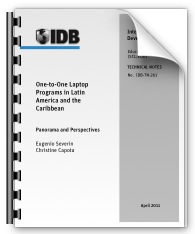The introduction of technology in education is gaining momentum worldwide. One model of incorporating technology into education that has gained tremendous traction in Latin America and the Caribbean is One-to-One computing. The term "One-to-One" refers to the ratio of digital devices per child so that each child is provided with a digital device, most often a laptop, to facilitate learning.
The objective of One-to-One Laptop Programs in Latin America and the Caribbean document is to provide an overview of One-to-One implementations with a regional focus on Latin America and the Caribbean. It also proposes a systemic approach to improve the quality of education in contexts of mass laptop distributions to students and teachers.
The rationales for implementing One-to-One initiatives are frequently clouded by short-term political goals or by pressure from technology vendors. Nevertheless, from what the Inter-American Development Bank (IDB) has observed, the rationales and desired impact of One-to-One initiatives fall into three main categories:
- From an economic perspective, technology is seen as playing a major role in both the production processes and the results that these processes yield. Through the introduction of effective laptop programs, students can be better prepared to enter a technology-saturated workplace, maintaining a level of economic competitiveness.
- From a social perspective, laptops in schools are seen as a way to help bridge social and digital divides. They also have the potential to provide computer and Internet access to families and community members who would not otherwise have access.
- From an educational perspective, it is believed that laptops can facilitate new educational practices that are student-centered. They may also support the development of new skills and abilities required in the 21st century.
One-to-One models have been implemented in many Latin American and Caribbean countries including Argentina, Bolivia, Brazil, Chile, Colombia, Ecuador, El Salvador, Haiti, Honduras, Jamaica, Mexico, Nicaragua, Paraguay, Peru, Trinidad & Tobago, Uruguay, and Venezuela. This paper provides an overview of these cases and others worldwide.
The manners by which One-to-One programs have been designed, implemented, and evaluated are very diverse. Thus far, research has been inconclusive with regards to the economic, social, and educational impacts of One-to-One programs due to short time spans, lack of appropriate evaluation methodologies, and lack of commitment to study impact, among other reasons.
Since results vary with time and implementation, impacts should be evaluated over short-, mid-, and long-term time spans. Given the IDB's experience with One-to-One initiatives in the region, we propose:
- A model of understanding One-to-One that focuses on the student and his/her learning results. Rather than describing the relationship between the digital device and the child, we describe One-to-One as the relationship between a child and learning, mediated by technology among other factors.
- A systemic approach to One-to-One design and implementation that simultaneously considers infrastructure, digital content, teacher training/support, community involvement, and policy. A general review of the Total Cost of Ownership (TCO) associated with these initiatives, which considers both the initial investment and its long-term sustainability.
- An emphasis on the role of monitoring and rigorous evaluations. There is no silver bullet in education; in this sense, technology is no different from other learning interventions. To achieve educational, social, and economic progress, factors other than the sole distribution of laptops must be considered.


